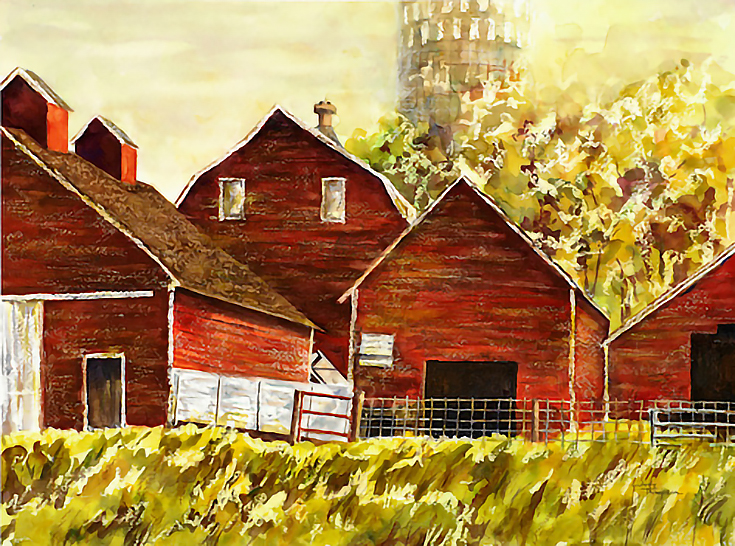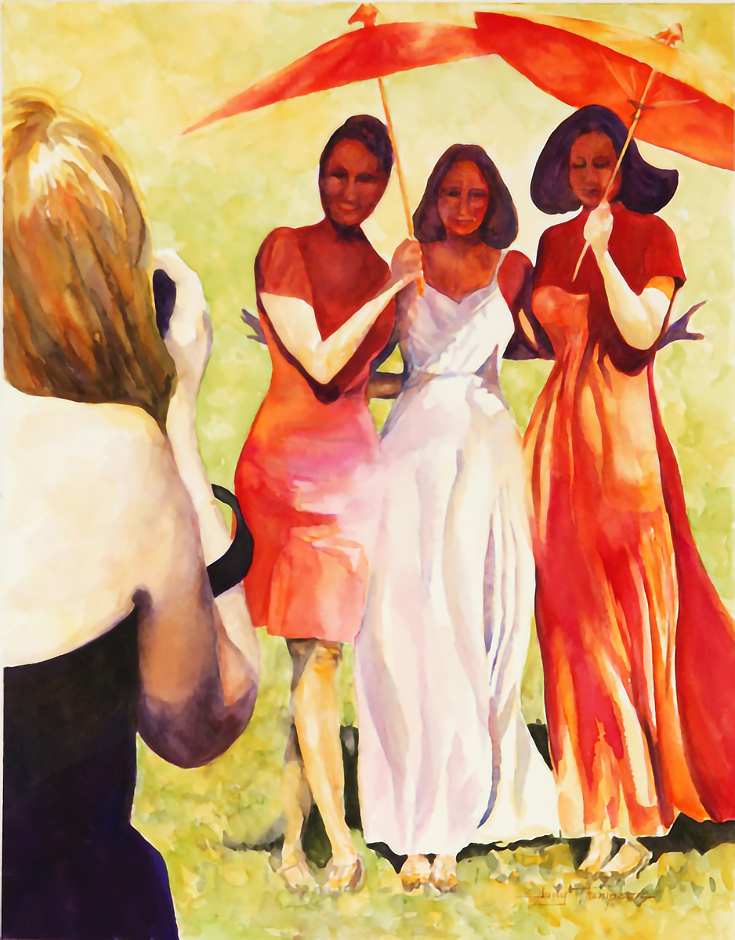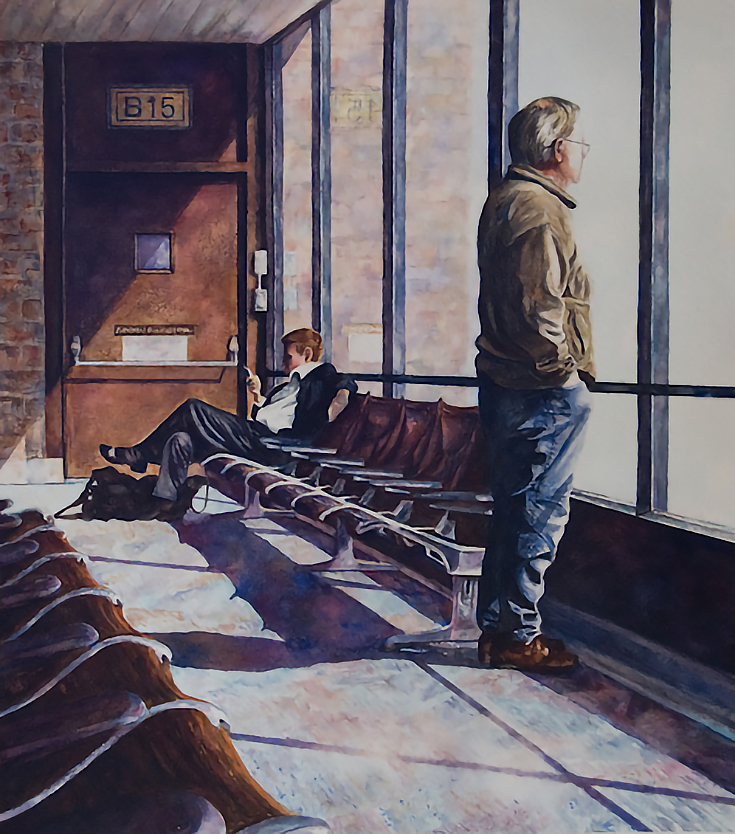
Though she’s won many awards since venturing out into the realm of “professional” art, one of her favorite projects has been creating art for the Sanford Children’s Hospital in Sioux Falls, SD.
Alyice: For those who have a hard time understanding how watercolor paints can be permanent, can you explain what watercolor paints are and how they work?
Judy: Watercolor paints are made from ground pigments (which provide the different colors or hues) and are mixed with gum arabic, glycerin and a wetting agent. When diluted with water, the gum arabic and glycerin allow the paints to be applied smoothly and to adhere to the paper. The wetting agent helps the paint flow evenly and makes it workable for the artist. Once the paint dries, it is quite stable. All watercolors, however, should be framed properly to protect against moisture and direct sunlight.
Alyice: How does creating art make you feel?
Judy: When I create art I have many emotions. It’s exciting to be inspired with a great idea. Working out the idea for a usable composition is also rewarding since I enjoy creative problem solving and the mental gymnastics of finding new possibilities.
Just before I begin putting paint to paper, I become anxious and almost agitated since I have to decide on colors, paper texture, approaches, etc. Once I work out the details and begin to paint, I become completely mesmerized and love watching the paints come alive before my eyes.
Alyice: Why did you choose watercolor as your medium?
Judy: There are two basic reasons why I prefer watercolor as my medium.
The first has to do with the versatility of watercolor. Watercolors have a beautiful transparent quality which is difficult to reproduce in other mediums. It also can be layered for rich darks and interesting textures.
The second reason I love watercolors is because I only need water when I paint and clean up. There are no harmful chemicals, strong odors or complicated mixing.
Alyice: On your website, you state that working with watercolors is exciting and unpredictable. Can you tell us more about why you feel this way?
Judy: Watercolor works best when it is allowed to flow freely and mingle on its own. As an artist I respect this quality by mixing my colors on the paper.
I do this by applying a wet area of one color and then touching another color into the area. Immediately the two pigments mix together and create a new color and shape.
As an artist, I cannot control exactly what the outcome will be—which makes for suspense, surprise, and sometimes aggravation. Watercolor also dries lighter than when applied, so the I am never quite sure what the finished project will look like. This unpredictable quality leads to many happy surprises.
Alyice: What is the best part about working with watercolors?
Judy: I love the fact that watercolors are so portable, can be carried wherever you go and are easy to clean up.
Alyice: What do you wish you knew about watercolors before you got started?
Judy: It was very confusing for me to understand all the differences between paints, (staining, granulating and opaque colors), qualities of paint, types and weights of paper and what kinds of brushes to buy. There are just so many products to choose from and many of the products are quite expensive. I read many books, asked many questions, and experimented with many materials. When I teach my workshops, I try to cover these basics so that my students can choose materials which will aid their success and then move on to the fun part—painting.
Alyice: You use a wax resist on your watercolor paintings. What is that?
Judy: Watercolor is unique in that the artist must “save the whites” of the paper. In a watercolor painting, the white areas are the areas where no paint is applied. (This is unlike oil or acrylic where white paint is usually applied last.)
To save the whites, a watercolorist needs to plan ahead. Usually the artist paints around the white areas or applies a resist.
A resist is any material that resists the paint. With a wax resist, I use a piece of paraffin which I rub on the areas I wish to remain white. As I paint over them, the wax resists the color and the area remains white. However a bit of the paint will bead on the waxed area which gives an interesting textural effect. This effect can also be done with wax crayons.
Alyice: What is your creative process like?
Judy: Once I become inspired by an idea, I play around with compositional design. I reduce my subject to simple shapes which I arrange in different ways.
I also play around with areas of light and dark, focal points and patterns. I draw these ideas out in my sketch book until I am satisfied. At that point I usually do a full-scaled drawing of the composition to work out any technical problems. I then transfer my drawing to the watercolor paper. After determining where I want to keep the paper white, I begin painting.
My technique can vary from painting to painting. Sometimes I pour layers of paint over the paper allowing the paint to dry between glazes. Other times I work specific areas and build up color slowly.
When I complete a painting I let it sit for a day or two. Many times I need to make various adjustments before I determine it’s a finished piece of artwork. My final step is framing the pieces correctly. I am very fortunate to work with a wonderful framer with the amazing ability to choose mats and frames which enhance my artwork.
Alyice: What do you believe is a key element in creating a good composition?
Judy: There are many key elements to creating a strong composition. Strong design, color harmony and draftsmanship are all important. However, I also think that strong value contrasts (areas of light and dark) make for the best compositions.
Alyice: When you look for something to paint, you pay close attention to dramatic lighting. What is dramatic lighting and how does it help you paint stronger pieces.
Judy: Dramatic lighting uses the lightest and darkest values on the value scale—from whitest white to darkest dark. Extreme value contrasts, such as these, create the most dramatic paintings and capture the viewer’s interest. By not painting all the details on both ends of the value scale, the artist allows the viewer to “fill in the blanks” and interactive with the artwork.
To view more of Judy Thompson’s paintings, please visit her art blog and website.
This post may contain affiliate links.




